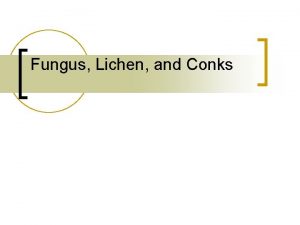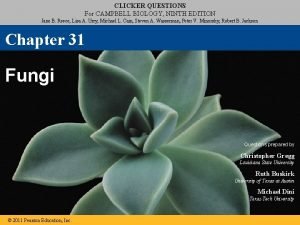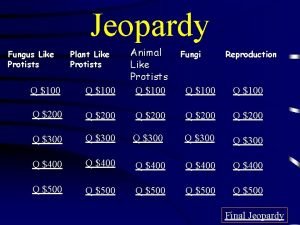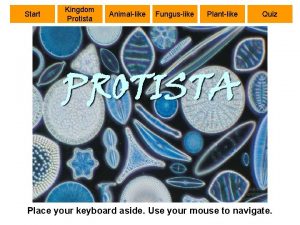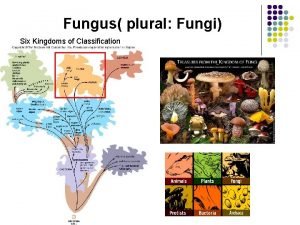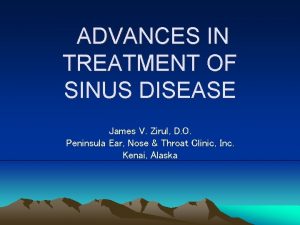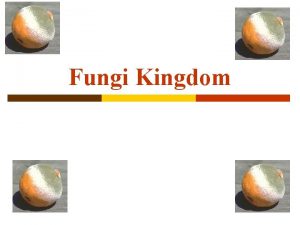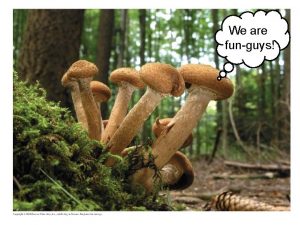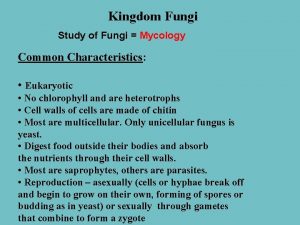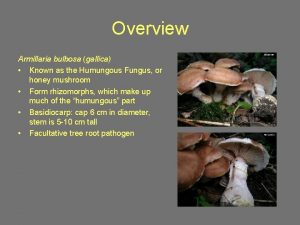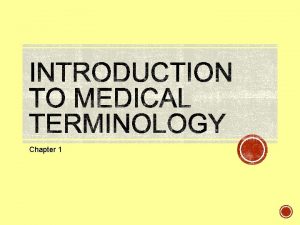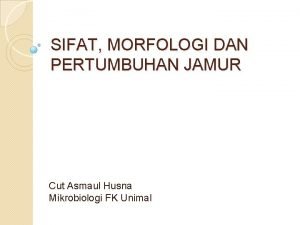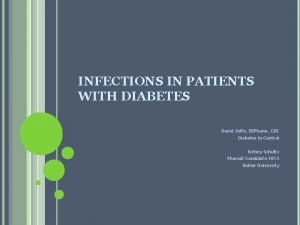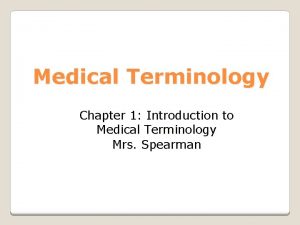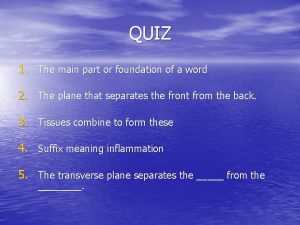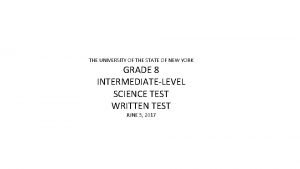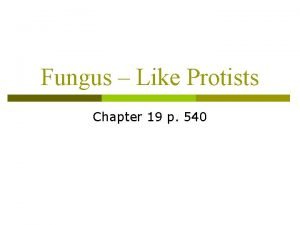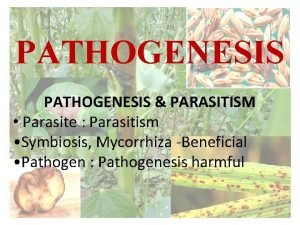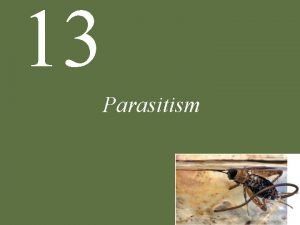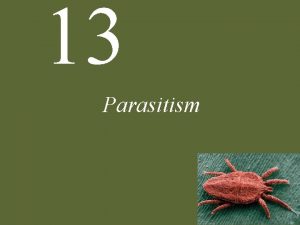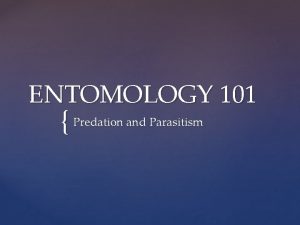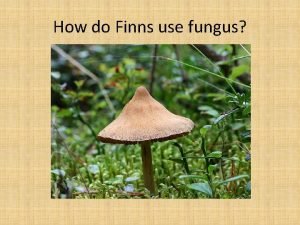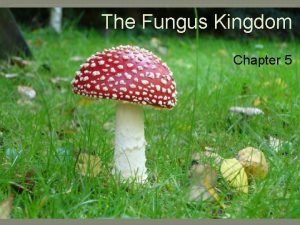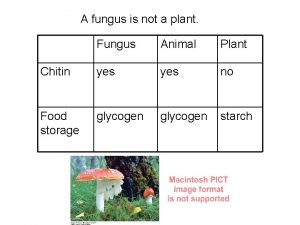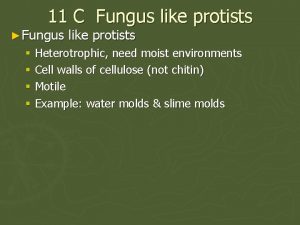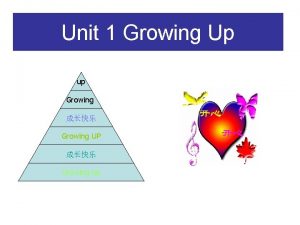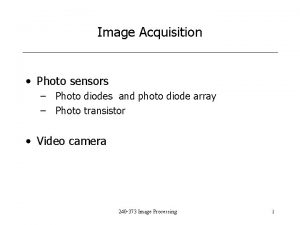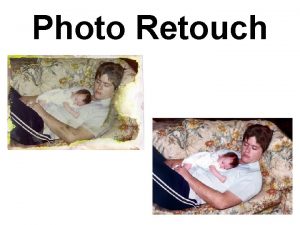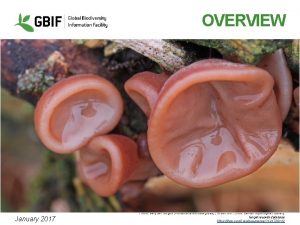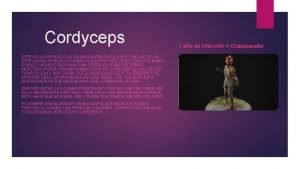Parasitism Photo of Cordyceps fungus growing out of




















- Slides: 20

Parasitism Photo of Cordyceps fungus growing out of the insect it parasitized from Wikimedia Commons

Exploitation (+/- or antagonistic interaction) Parasites consume tissues or fluids of their host organisms; typically infecting just 1 individual, generally without killing it (at least not immediately) Ectoparasite (external) vs. Endoparasite (internal) Macroparasite vs. Microparasite Free-living vs. Symbiont Complex Life Cycle (generally involving multiple host species) vs. Simple Life Cycle Horizontally Transmitted vs. Vertically Transmitted Photo of human head louse from Wikimedia Commons

Exploitation (+/- or antagonistic interaction) Pathogens Parasites that cause disease (which manifests as pain, dysfunction or death) Photomicrograph of an Ebola virion (a complete virus particle) from Wikimedia Commons

Brood Parasites Rely on other organisms to raise their young Photo of Reed Warbler & Cuckoo chick from Wikimedia Commons

Kleptoparasites Thieves (many are therefore competitors) Photo from http: //antediluviansalad. blogspot. com/2012_09_02_archive. html

Symbionts Live in close association with their hosts; amensal, commensal, parasitic, or mutualistic Some mutualistic defensive symbionts protect their hosts against parasitic symbionts Photomicrograph of endophytes in a plant from http: //www. entm. purdue. edu/turfgrass/research. html

Co-cladogenesis & co-speciation Two associated lineages (especially symbionts) diverge together, and potentially co-speciate Dipodomys merriami Photos from Wikimedia Commons; figure from Light & Hafner (2008) Systematic Biology Fahrenholzia pinnata

Horizontal vs. Vertical Transmission Horizontal – between individuals that are not linked by a parent-child relationship Vertical – from mother to offspring Mother Horizontal Other non-offspring member of the population Vertical Daughter Son or Horizontal Other non-parent member of the population

Cospeciation Host switch Duplication Host Parasite Failure to speciate From J. Weckstein (2003) Missing the boat Extinction Coexistence Which are most likely under strictly vertical transmission?

*When is it Coevolution? Reciprocal adaptive evolution in each of 2 interacting species in response to adaptations in the other species Tribolium castaneum is infected by microsporidian Nosema whitei; parasite virulence and host recombination frequencies co-evolve Photo of T. castaneum flour beetle from Wikimedia Commons; *original idea from Janzen (1980) Evolution

Macroparasite vs. Microparasite Catagories based on function rather than taxonomy or phylogenetics Macroparasites – parasites grow, but have no direct reproduction within the host (they produce infective stages that must colonize new hosts); typically much larger and have longer generation times than microparasites; immune response in host is typically absent or very shortlived; infections are often chronic as hosts are continually reinfected; e. g. , helminthes, arthropods, etc. Microparasites – parasites that reproduce within the host, often within the host’s cells, and are generally small and have short lifespans relative to their hosts; hosts that recover often have an immune period after infection (sometimes for life); infections are often transient; e. g. , bacterial, viral, fungal infectious agents, as well as many protozoans, etc.

Parasites can influence individuals, populations, interactions between species, communities & ecosystems Tribolium castaneum outcompetes T. confusum when both are healthy; T. confusum outcompetes T. castaneum in the presence of protist parasite Adelina tribolii (which is especially virulent towards T. castaneum) Cain, Bowman & Hacker (2014), Fig. 14. 17; after Park (1948)

Parasites can influence individuals, populations, interactions between species, communities & ecosystems Red Grouse are naturally infected by a nematode parasite; antihelminthics cure the infected hosts “Proportion of grouse treated… No treatment, dashed line; 5%, dotted line; 10%, thick solid Line; and 20%, thin solid line. ” Photo of from http: //www. pbase. com/wildbirdimages/image/129932709; fig. from Hudson et al. (1998) Science

Modeling Microparasite Disease Dynamics The SIR Model – a compartmental model (population is sub-divided into compartments) for epidemiology Birth a Susceptible hosts (S) a β transmission Infected hosts (I) α+b b Death After Anderson & May (1979 ab) & May (1983) a v recovery Recovered & Immune hosts (R) b

Modeling Microparasite Disease Dynamics Coupled differential equations; one for each host compartment: d. S/dt = fxn; d. I/dt = fxn; d. R/dt = fxn S, I & R are numbers of individuals; the other variables are rates Birth a Susceptible hosts (S) a β transmission Infected hosts (I) α+b b Death After Anderson & May (1979 ab) & May (1983) a v recovery Recovered & Immune hosts (R) b

Modeling Microparasite Disease Dynamics d. I/dt = βSI – (α + b + v)I d. I/dt = βSI – m. I βSI = Disease transmission rate m= combined death & recovery rate Birth a Susceptible hosts (S) a β transmission Infected hosts (I) α+b b Death After Anderson & May (1979 ab) & May (1983) a v recovery Recovered & Immune hosts (R) b

Modeling Microparasite Disease Dynamics If d. I/dt > 0, disease will establish & spread βSI – m. I > 0 ST > m / β We refer to this as the threshold density for disease progression What are the public policy or management implications?

Transmission & Virulence Transmission – passing a parasite or pathogen from an infected host to another individual Virulence – the host’s parasite-induced loss of fitness Host Fitness (Inversely related to Pathogen Virulence) Production & spread of disease organisms from a host (Transmission)

Darwinian (Evolutionary) Agriculture & Darwinian (Evolutionary) Medicine The application of modern evolutionary theory to understand crop & livestock production (Darwinian Agriculture) and human health & disease (Darwinian Medicine) E. g. , Why do new diseases continue to appear in human, crop & livestock populations?

Mind-Controlling Parasites “Cocoon web” of spider parasitized by specialist wasp Normal web Cain, Bowman & Hacker (2014), Fig. 14. 22, from Eberhard (2000) Nature & (2001) Journal of Arachnology; photo of Eberhard from http: //www. stri. si. edu/english/about_stri/ headline_news/article. php? id=1015 Bill Eberhard
 1d one thing
1d one thing Fungus lichen and conks
Fungus lichen and conks Evolutionary history
Evolutionary history Fungus jeopardy answer key
Fungus jeopardy answer key Paramecia use _________ to move and capture food.
Paramecia use _________ to move and capture food. Sexual or asexual reproduction
Sexual or asexual reproduction Ponaris fungus
Ponaris fungus Fungus phylum
Fungus phylum There's a fungus among us origin
There's a fungus among us origin 10 characteristics of fungi
10 characteristics of fungi Armillaria bulbosa
Armillaria bulbosa This word part means plaque or fatty substance.
This word part means plaque or fatty substance. Kelompok kapang yang tidak berhypha
Kelompok kapang yang tidak berhypha Coccidioides immitis
Coccidioides immitis Mucormycosis ppt
Mucormycosis ppt Fungus
Fungus Cyan medical term
Cyan medical term Seente paljunemine
Seente paljunemine Mycosis a suffix denoting an abnormal condition of fungus
Mycosis a suffix denoting an abnormal condition of fungus What do the rabbit, fungus, and tree have in common? *
What do the rabbit, fungus, and tree have in common? * What are fungus like protists
What are fungus like protists

